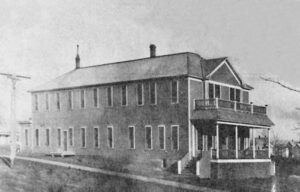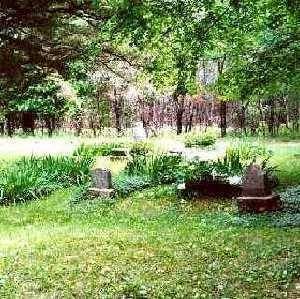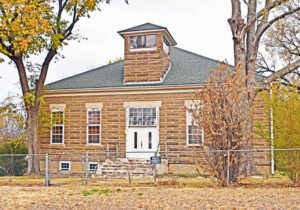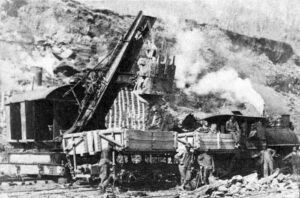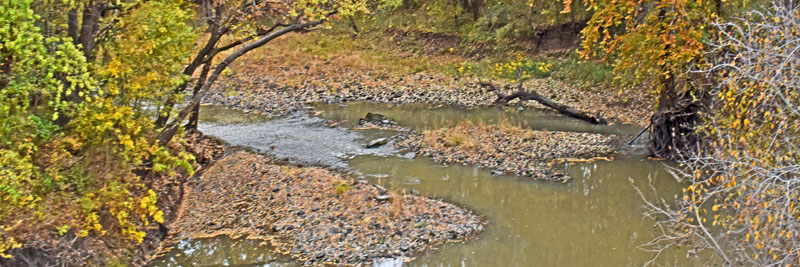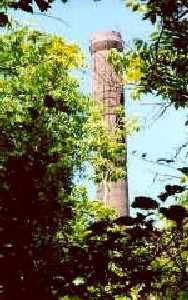
LeHunt, Kansas, old Smokestack.
Le Hunt, Kansas, in Montgomery County, was once a small town supported primarily by the United Kansas Portland Cement Company. A ghost town today, little is left of the town beyond a few old ruins of the cement plant, an old school, and a cemetery. Once a thriving community, the town can now only be discerned from overgrown avenues of trees, broken sidewalks, and foundations hidden by grass and heavy brush.
Le Hunt started in 1905 when the United Kansas Portland Cement Company, based in nearby Independence, Kansas, purchased 1,500 acres a few miles northwest of Independence and built a large factory. The site was chosen due to the area’s abundant supply of Portland cement minerals. The production of Portland cement is primarily dependent on the availability of limestone and shale in significant quantities. These deposits needed to be at or near the surface to eliminate the cost of removing overburden. These deposits were found in an area from Iola to Independence that included much of Allen, Neosho, Wilson, and Montgomery Counties.
The site of Table Mound, with an elevation of about 1,000 feet, was chosen as the ideal location for the plant. The town was named for Leigh Hunt, president of the Hunt Engineering Company of Michigan, who built multiple other plants, including one in Iola, Kansas. Leigh Hunt Construction officially started on October 20, 1905, by building a quarry atop the mound. A gravity system was used to transport materials, eliminating the need for elevators and expensive conveyors, which helped cut production costs. The plant was completed in August 1906.
The company initially employed 200 to 400 men, mostly immigrants who first lived in tents. To accommodate the factory’s many workers, a company town was established. The Hunt Engineering Company then began to build housing, a school, a church, and saloons. By 1906, the fledgling town had grown to be home to over 1,000 people. At its peak, there were two hotels, a grocery store, a church, a school, a livery stable, and other storefronts.
During these early years, Tom Mix, who would later become a famous cowboy actor and star in many early Western movies, served as the town marshal. Leigh Hunt knew Mix from the Spanish-American War and followed him to Independence, where he served as a foreman in charge of labor. When a group described as gamblers and bootleggers descended on the construction site on payday, Mix was appointed deputy sheriff and single-handedly rounded up the villains.
In the following years, the cement industry experienced an economic decline due to overproduction, resulting in mill consolidation. In January 1908, the cement plants at Le Hunt, Iola, and Neodesha consolidated to form the United Kansas Portland Cement Company, with a capitalization of $12,750,000. Consolidation reduced maintenance and operating costs, allowed cement contracts to be fulfilled more effectively, and eliminated competition among themselves. Though the consolidation helped, it wouldn’t last. Another blow came when the railroads raised their long-haul freight rates, leading to a decrease in cement production in southeastern Kansas. In addition to these challenges, natural gas depletion in the area by 1912 temporarily incapacitated cement production.
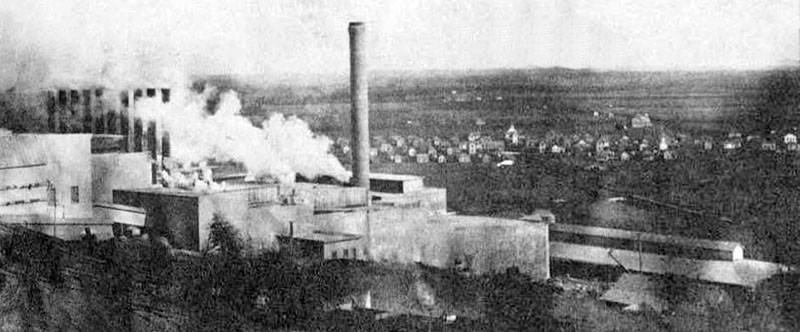
United Kansas Portland Cement Company with the town of Le Hunt in the background, about 1910.
On March 25, 1913, an accident injured three employees when an explosion of oil in a tank fed the machinery engine at about 6:30 a.m., causing Leonard Ioeger, Frank Anderson, and a man named Calhoun to be severely burned.
In June 1913, a local newspaper announced that the plant would be temporarily closed to make repairs and sell its surplus stock. However, the shutdown turned out to be permanent, and the United Kansas Portland Cement Company filed for bankruptcy on January 15, 1914. Stockholders of United Kansas lost approximately $ 297,000 when the company declared bankruptcy.
In 1915, the plant was purchased by the Sunflower Portland Cement Company for $199,950. After making repairs, the plant reopened on September 12, 1915. Within 30 days, the houses were filled again, businesses reopened, and the school was reopened. The new company employed over 300 people and had a daily capacity of 1,500 barrels. Cement prices hit an all-time high in 1916-1917.
After World War I, demand for cement reduced, causing a steep drop in production. This soon led to the closure and selling of the Sunflower Portland Cement Company to the Western States Portland Cement Company in 1918. After a series of mergers and purchases, it became a part of the United States Steel Corporation. These events led to the Le Hunt plant closing, its equipment being sold, and many of its homes being moved elsewhere.
With limited housing and no major company to anchor the settlement, Le Hunt faded until it was a ghost town.
All that remains of the town of Le Hunt is the dilapidated cement factory, a few abandoned homes, an old cemetery, a nearby brick school, and other remnants that nature has reclaimed.
Today, the ruins of the cement plant remain in the woods off County Road 5000. The factory’s long-abandoned smoke stack, which rises above the tree line, is most prominent.
The old cemetery is about a half mile north of the factory site, with graves dating back to the late 1860s.
The old site of the cement plant is said to be haunted by the ghost of one of the workers by the name of Bohr, who died in a tragic accident at the plant. As the story goes, Bohr fell into a vat of concrete, and his body was never recovered. After this disastrous event, his co-workers embedded his wheelbarrow, pick, and shovel into a concrete wall under construction. His name, as well as his pickaxe, can still be seen in the factory ruins.
From Independence, take US-75/US-160 west .2 miles and turn right on Peter Pan Road, traveling north for two miles. The road will change to County Road 3525, and you will continue for one mile. Then take a left on 5000 Road for ½ mile.
© Kathy Alexander/Legends of America, updated April 2025.
Also See:
Sources:
Abandoned Kansas
Hutchinson News
The Independence Evening Star, March 25, 1913
Only In Your State
Ratzlaff, Robert; Le Hunt, Kansas – The Making of a Cement Ghost Town, Kansas Historical Quarterly, Summer, 1977
Wikipedia


